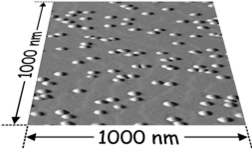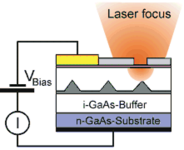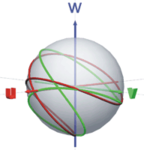Quantum information technology
Semiconductor quantum dots are artificial atoms contained in a host crystal. Their absorption and emission spectra appear as atomically sharp lines. By resonant optical excitation with a tunable laser system it is possible to generate or annihilate excitons (single electron-hole pairs) in the ground state of a quantum dot. With ps laserpulses it is possible to control excitons fast and efficiently in a defined way. Under those conditions, an exciton can be described as a quantum bit (qubit), which can be coherently manipulated in amplitude and phase.
For our experiments we use self-assembled InAs/GaAs and InAs/InP quantum dots, which are grown by molecular beam epitaxy (MBE). From this material we produce single quantum dot photodiodes and photonic micro-resonators by electron beam lithography and wet-chemical or reactive ion etching.
Using photocurrent spectroscopy we have been able to demonstrate Rabi-oscillations of exciton qubits on ps time scales. A Rabi flop by means of an optical π-pulse corresponds to a basic qubit rotation in the context of quantum computing. Photocurrent detection revealed an optically triggered single electron turnstile effect, which is based on the transfer of coherent optical excitations into deterministic photocurrents. This concept allows for a quantitative readout of the occupancy of a single quantum system. For optical excitation with π-pulses a quantitative photocurrent I=fe is obseved, where f is the repetition frequency of the experiment and e is the elementary charge. In the focus of our current interests are further the coherent state preparation as a basis for efficient single photon emitters and the Ramsey-interference as a basis for the implementation of novel optoelectronic quantum gates. Our research activities in this area are funded by the BMBF “Q.com” program. The ongoing activities are designed to contribute to the new fields of coherent optoelectronics and quantum communication.



